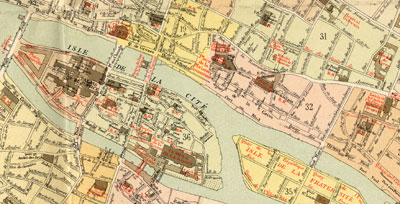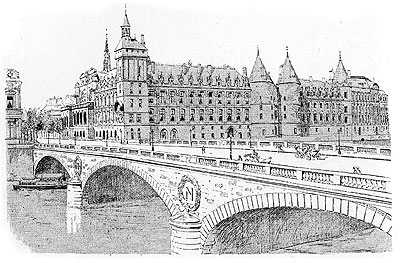|

NOTES ON ISSUE 12: GLOSSARY
PART 3 OF 3
No fight could have been half so
terrible as this dance. It was so emphatically a fallen sport – a
something once innocent delivered over to all devilry – a healthy
pastime changed into a means of angering the blood, bewildering the
senses, and steeling the heart.... This was the Carmagnole.
The “Carmagnole,” a patriotic dance
“popular among the French revolutionists of 1793” (OED),
originally referred to “a kind of dress much worn in France during the
Revolution of 1789” (OED). This dress, named after the Italian
town of Carmagnola, was a Piedmontese peasant costume well known in
southern France (Piedmont, a region of northwestern Italy, is adjacent
to the southeastern part of France), and introduced into Paris by the
Marseillais revolutionaries in 1789 (Marseilles is a coastal city in
southern France, on the Mediterranean). It
consisted of a short skirted coat
with rows of metal buttons, a tricoloured waistcoat and red cap, and
became the popular dress of the Jacobins. The name was then given to
the famous revolutionary song, composed in 1792, the tune of which, and
the wild dance which accompanied it, may have also been brought into
France by the Piedmontese. (“Carmagnole,” 1911 Edition Encyclopedia)
The lyrics to the Carmagnole varied during
the course of the Revolution, but originally calumniated Louis
XVI (as “Monsieur Veto” because of his power to
delay the proposals of the revolutionary legislature [until
his seizure and imprisonment after August 10, 1792]), and later
Marie-Antoinette (as “Madame Veto” – apparently
as the consort of Monsieur Veto, Louis XVI). Lyrics and a recording
of the Carmagnole as it would have been sung in late 1793 (after
the beheading of Marie-Antoinette in October) can be accessed
at the website “Liberty, Equality, Fraternity: Exploring
the French Revolution,” under “Songs,” http://chnm.gmu.edu/revolution.
(From the main page, either do a “Quick Search”
for “Carmagnole” or click on “Browse”
and scroll down to “Songs”; then, in “Browse
Songs,” scroll down and click on “The Carmagnole.”)
He has not received the notice yet, but I know that he will presently
be summoned for to-morrow, and removed to the Conciergerie…
The Conciergerie, the oldest prison in Paris, is adjacent to the Palais
de Justice on the Ile de la Cité. During the Revolution, it was
the prison to which suspects were removed just before trial; thus,
Darnay’s summons to the Conciergerie means that his trial is imminent.
In the 19th century, the Conciergerie was still used as a prison for
those awaiting trial, and the chamber of Marie-Antoinette (perhaps the
most famous person to have been held there during the Revolution) was
converted into a chapel. This chamber was gutted by fire in 1871
(Baedeker 219), but afterwards restored, and can still be seen today.
The Conciergerie is visible on this portion of
the Plan de la Ville de Paris, Période
Révolutionnaire, 1790-1794 (on the northwestern
side of the Ile de la Cité, just above the Palais de
Justice).

Click on
map for larger view
This image of the Conciergerie (below), with
the Seine in the foreground, is taken from Dumas’ Paris
(1889). Though the Conciergerie underwent considerable
rebuilding and restoration in the 19th century (before this
illustration was created), many of the oldest parts of the building
remain to this day. For instance, the pointed towers date
from the 14th century, and would have been familiar to those
incarcerated in the Conciergerie during the French Revolution.

The dread Tribunal of five Judges, Public
Prosecutor, and determined Jury, sat every day.
This “dread Tribunal” is the revolutionary judicial body which –
particularly active during the Reign of Terror – decided the fate of
those, like Darnay, who were suspected of being traitors to the
Revolution. Dickens’ anatomy of this Tribunal follows Carlyle’s account
in The French Revolution:
Very
notable also is the Tribunal Extraordinaire: decreed by the
Mountain [the Jacobin party]; some Girondins [the moderate
revolutionary party ultimately demolished by the Jacobins] dissenting,
for surely such a Court contradicts every formula; – other Girondins
assenting, nay co-operating, for do not we all hate Traitors, O ye
people of Paris?… Five Judges; a standing Jury, which is named from
Paris and the Neighborhood, that there be not delay in naming it: they
are subject to no appeal; to hardly any Law-forms, but must “get
themselves convinced” in all readiest ways; and for security are bound
“to vote audibly”; audibly, in the hearing of a Paris Public. This is
the Tribunal Extraordinaire; which, in a few months, getting
into most lively action, shall be entitled Tribunal
Révolutionnaire; as indeed it from the very first has
entitled itself: with a Herman and a Dumas for Judge President, with a
Fouquier-Tinville for Attorney-General, and a Jury of such as Citizen
Leroi, who has surnamed himself Dix-Août, "Lerio August-Tenth” [in
commemoration of the day the King was suspended from office, previous
to his incarceration and execution], it will become the wonder of the
world. Herein has Sansculottism fashioned for itself a Sword of
Sharpness: a weapon magical; tempered in the Stygian hell-waters; to
the edge of it all armour, and defence of strength or of cunning shall
be soft; it shall mow down Lives and Brazen-gates; and the waving of it
shed terror through the souls of men. (623-4)
Ultimately, at the height of the
Terror, this Tribunal was extended into four Tribunals, and the rate of
execution was sped proportionally (Carlyle 730).
…some games of forfeits and a little concert, for
that evening.
The Dictionary of Daily Wants (1859) describes the “game of
forfeits” as follows:
FORFEITS.
– A pastime usually played by a number of persons of both sexes. The
ordinary mode is to select some sentence, which each person of the
party is to repeat without making a mistake, and in the event of his so
doing, he has to forfeit to some person chosen for the purpose any
trifling article, such as a card-case, smelling-bottle, fan, &c.
When the sentence has gone the round of the party, one of the company
has to kneel with her head in the lap of the person holding the
forfeits; this latter person holds up the forfeits one by one in sight
of the whole company, and says, “Here’s a pretty thing, a very pretty
thing, and what’s to be done to the owner of this pretty thing?” The
person kneeling down has then to impose some penalty which involves
some ludicrous situation, and is calculated to produce laughter and
good humour among the company present. This accomplished, the forfeited
article is returned to the owner. By this it is evident that the person
who has to impose the forfeits should possess a fund of humour and
ready invention; and, to ensure uninterrupted sport, some person should
be selected gifted with these attributes. (440)
Under the circumstances (incarceration
prior to execution by guillotine), this game seems somewhat
horribly appropriate, for the very name invokes a penalty or loss (a
forfeit is something the right to which is lost through the
commission of a crime or a fault of some kind [OED]).
Charles Evrémonde, called Darnay, was
accused by the public prosecutor as an aristocrat and an emigrant,
whose life was forfeit to the Republic, under the decree which banished
all emigrants on pain of Death.
On September 17, 1793, the Revolutionary government decreed that,
according to a new “Law of the Suspect,” France be purged of its
nobility (as Carlyle describes it, “…so has the Convention decreed: Let
Aristocrats, Federalists, Monsieurs vanish, and all men tremble: ‘the
Soil of Liberty shall be purged,’ – with a vengeance!” [667]).
Darnay, entering France in August of
1792, returned before the laws under which he is tried had officially
been passed.
On his coming out, the concourse made at him anew,
weeping, embracing, and shouting, all by turns and all together, until
the very tide of the river on the bank of which the mad scene was
acted, seemed to run mad, like the people on the shore.
The river “on the bank of which the mad scene” is acted is of course
the Seine. The Conciergerie, standing on the north side of the Ile de
la Cité, looks out over the river.
Then, they elevated into the vacant chair a young
woman from the crowd to be carried as the Goddess of Liberty…
Dickens’ representation of this impromptu elevation of a “Goddess of
Liberty” probably draws on various acts of patriotic idolatry described
in Carlyle’s French Revolution. On August 10, 1793, a huge
terra-cotta statue of “Liberty” was unveiled in the Place de la
Révolution (Carlyle 657-8), on the site of the former
statue of Louis XV (which had been erected when the Place de la
Révolution was still the Place de Louis XV); and on November 10,
1793, a “Goddess of Reason” was installed in Notre Dame (which itself
was newly converted into a “Temple of Reason”). Carlyle describes this
goddess’ elevation as follows:
For
this same day, while [the] brave Carmagnole-dance has hardly jigged
itself out, there arrive Procureur Chaumette and Municipals and
Departmentals, and with them the strangest freightage: a New Religion!
Demoiselle Candeille, of the Opera; a woman fair to look upon when well
rouged; she, borne on palanquin shoulder high; with red woolen
night-cap; in azure mantle; garlanded with oak; holding in her hand the
Pike of the Jupiter-Peuple, sails in; heralded by white young
women girt in tricolor. Let the world consider it! This, O National
Convention wonder of the universe, is our New Divinity, Goddess of
Reason, worthy, and one worthy of revering. Her henceforth we
adore. Nay, were it too much to ask of an august National
Representation that it also went with us to the ci-devant
Cathedral called of Notre-Dame, and executed a few strophes in worship
of her? (696)
Demoiselle Candeille of the
Opéra was not the only woman elevated to goddess-status for this
Feast of Reason; others were elevated in other churches, and Carlyle
notes that one “Mrs. Momoro, it is admitted, made one of the best
Goddesses of Reason; though her teeth were a little defective” (697).
It was the ordinance of the Republic … that on the
door or doorpost of every house, the name of every inmate must be
legibly inscribed in letters of a certain size, at a certain convenient
height from the ground.
Dickens draws this detail of the house-doors directly from Carlyle, who
notes that
In
Paris and all Towns, every house-door must have the names of the
inmates legibly printed on it, “at a height not exceeding five feet
from the ground”; every Citizen must produce his certificatory Carte
de Civisme signed by Section-President; every man be ready to give
account of the faith that is in him. (623)
“Old Nick’s.”
Old Nick is a name for the devil; the derivation of this nick-name,
however, has never been successfully traced (OED).
Bibliographical information
|

